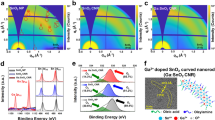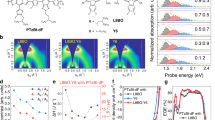Abstract
Solution processing is a promising route for the realization of low-cost, large-area, flexible and lightweight photovoltaic devices with short energy payback time and high specific power. However, solar cells based on solution-processed organic, inorganic and hybrid materials reported thus far generally suffer from poor air stability, require an inert-atmosphere processing environment or necessitate high-temperature processing1, all of which increase manufacturing complexities and costs. Simultaneously fulfilling the goals of high efficiency, low-temperature fabrication conditions and good atmospheric stability remains a major technical challenge, which may be addressed, as we demonstrate here, with the development of room-temperature solution-processed ZnO/PbS quantum dot solar cells. By engineering the band alignment of the quantum dot layers through the use of different ligand treatments, a certified efficiency of 8.55% has been reached. Furthermore, the performance of unencapsulated devices remains unchanged for over 150 days of storage in air. This material system introduces a new approach towards the goal of high-performance air-stable solar cells compatible with simple solution processes and deposition on flexible substrates.
This is a preview of subscription content, access via your institution
Access options
Subscribe to this journal
Receive 12 print issues and online access
$259.00 per year
only $21.58 per issue
Buy this article
- Purchase on Springer Link
- Instant access to full article PDF
Prices may be subject to local taxes which are calculated during checkout




Similar content being viewed by others
References
Graetzel, M., Janssen, R. A. J., Mitzi, D. B. & Sargent, E. H. Materials interface engineering for solution-processed photovoltaics. Nature 488, 304–312 (2012).
Wadia, C., Alivisatos, A. P. & Kammen, D. M. Materials availability expands the opportunity for large-scale photovoltaics deployment. Environ. Sci. Technol. 43, 2072–2077 (2009).
Zarghami, M. H. et al. p-Type PbSe and PbS quantum dot solids prepared with short-chain acids and diacids. ACS Nano 4, 2475–2485 (2010).
Tang, J. et al. Colloidal-quantum-dot photovoltaics using atomic-ligand passivation. Nature Mater. 10, 765–771 (2011).
Ip, A. H. et al. Hybrid passivated colloidal quantum dot solids. Nature Nanotech. 7, 577–582 (2012).
Choi, J. J. et al. Photogenerated exciton dissociation in highly coupled lead salt nanocrystal assemblies. Nano Lett. 10, 1805–1811 (2010).
Semonin, O. E. et al. Peak external photocurrent quantum efficiency exceeding 100% via MEG in a quantum dot solar cell. Science 334, 1530–1533 (2011).
Johnston, K. W. et al. Schottky-quantum dot photovoltaics for efficient infrared power conversion. Appl. Phys. Lett. 92, 151115 (2008).
Pattantyus-Abraham, A. G. et al. Depleted-heterojunction colloidal quantum dot solar cells. ACS Nano 4, 3374–3380 (2010).
Luther, J. M. et al. Stability assessment on a 3% bilayer PbS/ZnO quantum dot heterojunction solar cell. Adv. Mater. 22, 3704–3707 (2010).
Zhao, N. et al. Colloidal PbS quantum dot solar cells with high fill factor . ACS Nano 4, 3743–3752 (2010).
Tang, J. et al. Quantum junction solar cells. Nano Lett. 12, 4889–4894 (2012).
Rath, A. K. et al. Solution-processed inorganic bulk nano-heterojunctions and their application to solar cells. Nature Photon. 6, 529–534 (2012).
Chang, L-Y., Lunt, R. R., Brown, P. R., Bulović, V. & Bawendi, M. G. Low-temperature solution-processed solar cells based on PbS colloidal quantum dot/CdS heterojunctions. Nano Lett. 13, 994–999 (2013).
Ning, Z. et al. Graded doping for enhanced colloidal quantum dot photovoltaics. Adv. Mater. 25, 1719–1723 (2013).
Yuan, M. et al. Doping control via molecularly engineered surface ligand coordination. Adv. Mater. 25, 5586–5592 (2013).
Jean, J. et al. ZnO nanowire arrays for enhanced photocurrent in PbS quantum dot solar cells. Adv. Mater. 25, 2790–2796 (2013).
Soreni-Harari, M. et al. Tuning energetic levels in nanocrystal quantum dots through surface manipulations. Nano Lett. 8, 678–684 (2008).
Jasieniak, J., Califano, M. & Watkins, S. E. Size-dependent valence and conduction band-edge energies of semiconductor nanocrystals. ACS Nano 5, 5888–5902 (2011).
Brown, P. R. et al. Energy level modification in lead sulfide quantum dot thin films through ligand exchange. ACS Nano http://pubs.acs.org/doi/abs/10.1021/nn500897c (2014).
Shrotriya, V., Li, G., Yao, Y., Chu, C-W. & Yang, Y. Transition metal oxides as the buffer layer for polymer photovoltaic cells. Appl. Phys. Lett. 88, 073508 (2006).
Meyer, J. et al. Transition metal oxides for organic electronics: Energetics, device physics and applications. Adv. Mater. 24, 5408–5427 (2012).
Gao, J. et al. n-type transition metal oxide as a hole extraction layer in PbS quantum dot solar cells. Nano Lett. 11, 3263–3266 (2011).
Brown, P. R. et al. Improved current extraction from ZnO/PbS quantum dot heterojunction photovoltaics using a MoO3 interfacial layer . Nano Lett. 11, 2955–2961 (2011).
Gao, J. et al. Quantum dot size dependent J–V characteristics in heterojunction ZnO/PbS quantum dot solar cells. Nano Lett. 11, 1002–1008 (2011).
Greiner, M. T. et al. Universal energy-level alignment of molecules on metal oxides. Nature Mater. 11, 76–81 (2012).
Meyer, J., Shu, A., Kröger, M. & Kahn, A. Effect of contamination on the electronic structure and hole-injection properties of MoO3/organic semiconductor interfaces. Appl. Phys. Lett. 96, 133308 (2010).
Irfan, et al. Energy level evolution of air and oxygen exposed molybdenum trioxide films. Appl. Phys. Lett. 96, 243307 (2010).
Hines, M. A. & Scholes, G. D. Colloidal PbS nanocrystals with size-tunable near-infrared emission: Observation of post-synthesis self-narrowing of the particle size distribution. Adv. Mater. 15, 1844–1849 (2003).
Beek, W. J. E., Wienk, M. M., Kemerink, M., Yang, X. & Janssen, R. A. J. Hybrid zinc oxide conjugated polymer bulk heterojunction solar cells. J. Phys. Chem. B 109, 9505–9516 (2005).
Acknowledgements
The authors thank R. Brandt for help with the J–V measurements in air, T. Buonassisi for the use of the solar simulator in air, M. Baldo for the use of the UPS system, and J. Jean for help with refractive index measurements. C-H.M.C thanks L-Y. Chang, D. Wanger, D-K. Ko, A. Maurano, I. Coropceanu and C. Chuang for fruitful discussions and technical assistance. P.R.B. was supported by the Fannie and John Hertz Foundation and the National Science Foundation. This work was supported by Samsung Advanced Institute of Technology. Part of this work made use of the MRSEC Shared Experimental Facilities at the MIT Center for Materials Science and Engineering (CMSE), supported by the National Science Foundation under award number DMR-08-19762, and the MIT Laser Biomedical Research Center (LBRC) under contract number 9-P41-EB015871-26A1, supported by the National Institute of Health.
Author information
Authors and Affiliations
Contributions
C-H.M.C and M.G.B. conceived and designed the project. C-H.M.C. performed most of the experiments and data analysis with some technical assistance from P.R.B. P.R.B. and C-H.M.C. performed UPS measurements and carried out their analysis. All authors discussed the results. C-H.M.C. wrote the manuscript with contributions from all authors.
Corresponding author
Ethics declarations
Competing interests
The authors declare no competing financial interests.
Supplementary information
Supplementary Information
Supplementary Information (PDF 4096 kb)
Rights and permissions
About this article
Cite this article
Chuang, CH., Brown, P., Bulović, V. et al. Improved performance and stability in quantum dot solar cells through band alignment engineering. Nature Mater 13, 796–801 (2014). https://doi.org/10.1038/nmat3984
Received:
Accepted:
Published:
Issue Date:
DOI: https://doi.org/10.1038/nmat3984
This article is cited by
-
Modification of low temperature solution–processed NiO with Me-4PACz for efficient and air-stable p-i-n perovskite solar cells
Journal of Solid State Electrochemistry (2024)
-
Revealing the origin of the photo-instability to improve the performance of PbS quantum dot solar
Nano Research (2024)
-
Dry Transfer Printed Hole Transport Layer for Hysteresis-Free Colloidal Quantum Dot Solar Cells
International Journal of Precision Engineering and Manufacturing-Green Technology (2024)
-
Optical engineering of PbS colloidal quantum dot solar cells via Fabry–Perot resonance and distributed Bragg reflectors
Nano Convergence (2023)
-
Potential window alignment regulating ion transfer in faradaic junctions for efficient photoelectrocatalysis
Nature Communications (2023)



